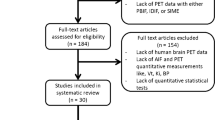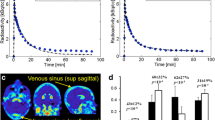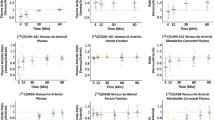Abstract
Objective
In a positron emission tomography (PET) study, the concentrations of the labeled drug (radiotracer) are often different in arterial and venous plasma, especially immediately following administration. In a PET study, the transfer of the drug from plasma to brain is usually described using arterial plasma concentrations, whereas venous sampling is standard in clinical pharmacokinetic studies of new drug candidates. The purpose of the study was to demonstrate the modeling of brain drug kinetics based on PET data in combination with venous blood sampling and an arterio-venous transform (Tav).
Methods
Brain kinetics (Cbr) was described as the convolution of arterial plasma kinetics (Car) with an arterial-to-brain impulse response function (Tbr). The arterial plasma kinetics was obtained as venous plasma kinetics (Cve) convolved with the inverse of the arterio-venous transform (Tav −1). The brain kinetics was then given by Cbr=Cve*Tav −1*Tbr. This concept was applied on data from a clinical PET study in which both arterial and venous plasma sampling was done in parallel to PET measurement of brain drug kinetics. The predictions of the brain kinetics based on an arterial input were compared with predictions using a venous input with and without an arterio-venous transform.
Results
The venous based models for brain distribution, including a biexponential arterio-venous transform, performed comparably to models based on arterial data and better than venous based models without the transform. It was also shown that three different brain regions with different shaped concentration curves could be modeled with a common arterio-venous transform together with an individual brain distribution model.
Conclusion
We demonstrated the feasibility of modeling brain drug kinetics based on PET data in combination with venous blood sampling and an arterio-venous transform. Such a model can in turn be used for the calculation of brain kinetics resulting from an arbitrary administration mode by applying this model on venous plasma pharmacokinetics. This would be an important advantage in the development of drugs acting in the brain, and in other circumstances when the effect is likely to be closer related to the brain than the plasma concentration.


Similar content being viewed by others
References
Akaike H (1973) Information theory and extension of maximum likelihood principle. 2nd International Symposium in Information Theory: 267–281
Bergstrom M, Grahnen A, Langstrom B (2003) Positron emission tomography microdosing: a new concept with application in tracer and early clinical drug development. Eur J Clin Pharmacol 59:357–366
Bergstrom M, Yates R, Wall A, Kagedal M, Syvanen S, Langstrom B (2006) Blood-Brain Barrier Penetration of Zolmitriptan-Modelling of Positron Emission Tomography Data. J Pharmacokinet Pharmacodyn.: 1–17
Chiou WL, Lam G, Chen ML, Lee MG (1981) Arterial-venous plasma concentration differences of six drugs in the dog and rabbit after intravenous administration. Res Commun Chem Pathol Pharmacol 32:27–39
Galluppi GR, Rogge MC, Roskos LK, Lesko LJ, Green MD, Feigal DW Jr, Peck CC (2001) Integration of pharmacokinetic and pharmacodynamic studies in the discovery, development, and review of protein therapeutic agents: a conference report. Clin Pharmacol Ther 69:387–399
Gunn RN, Gunn SR, Cunningham VJ (2001) Positron emission tomography compartmental models. J Cereb Blood Flow Metab 21:635–652
Gunn RN, Gunn SR, Turkheimer FE, Aston JA, Cunningham VJ (2002) Positron emission tomography compartmental models: a basis pursuit strategy for kinetic modeling. J Cereb Blood Flow Metab 22:1425–1439
Lammertsma AA (2002) Radioligand studies: imaging and quantitative analysis. Eur Neuropsychopharmacol 12:513–516
Lesko LJ, Rowland M, Peck CC, Blaschke TF (2000) Optimizing the science of drug development: opportunities for better candidate selection and accelerated evaluation in humans. Pharm Res 17:1335–1344
MathWorks, (2002) MATLAB The Language of Technical Computing; Using MATLAB
Pitsiu M, Gries JM, Benowitz N, Gourlay SG, Verotta D (2002) Modeling nicotine arterial-venous differences to predict arterial concentrations and input based on venous measurements: application to smokeless tobacco and nicotine gum. J Pharmacokinet Pharmacodyn 29:383–402
Porchet HC, Benowitz NL, Sheiner LB, Copeland JR (1987) Apparent tolerance to the acute effect of nicotine results in part from distribution kinetics. J Clin Invest 80:1466–1471
Tuk B, Herben VM, Mandema JW, Danhof M (1998) Relevance of arteriovenous concentration differences in pharmacokinetic-pharmacodynamic modeling of midazolam. J Pharmacol Exp Ther 284:202–207
Acknowledgements
We wish to thank the staffs at Uppsala Imanet and Quintiles for creating excellent research conditions.
Author information
Authors and Affiliations
Corresponding author
Appendices
Appendix I: The inverse of a biexponential arterio-venous transform \({\left( {T_{{av2}} = A_{1} e^{{ - a_{1} t}} + A_{2} e^{{ - a_{2} t}} } \right)}\)
The parameters c1−c4 are combinations of the arterio-venous transform parameters (A1, A2, a1 and a2):
Appendix II: Run test
where G is the number of runs (a run is a sequence of residuals with the same sign), μG is the expected number of runs and σG is the standard deviation. μG and σG are calculated as following:
where m and n are the number of residuals with positive and negative sign, respectively.
The test variable (TS) is compared with a critical value obtained from a z-table. Hence, randomness will be rejected at a 5% level of significance if TS is larger than 1.96 or smaller than –1.96.
Appendix III: Akaike information coefficient
where N is the number of measurements, RSS is the residual sum of squares and P is the number of free parameters.
Rights and permissions
About this article
Cite this article
Syvänen, S., Blomquist, G., Appel, L. et al. Predicting brain concentrations of drug using positron emission tomography and venous input: modeling of arterial-venous concentration differences. Eur J Clin Pharmacol 62, 839–848 (2006). https://doi.org/10.1007/s00228-006-0179-y
Received:
Accepted:
Published:
Issue Date:
DOI: https://doi.org/10.1007/s00228-006-0179-y




